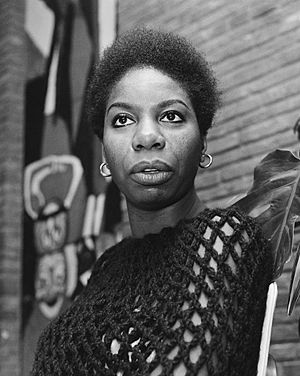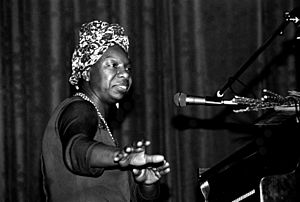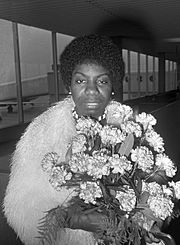Nina Simone facts for kids
Quick facts for kids
Nina Simone
|
|
|---|---|

Simone in 1965
|
|
| Background information | |
| Birth name | Eunice Kathleen Waymon |
| Born | February 21, 1933 Tryon, North Carolina, U.S. |
| Died | April 21, 2003 (aged 70) Carry-le-Rouet, France |
| Genres | |
| Occupation(s) |
|
| Instruments |
|
| Years active | 1954–2003 |
| Labels |
|
| Signature | |
 |
|
Nina Simone (born Eunice Kathleen Waymon; February 21, 1933 – April 21, 2003) was an American singer, songwriter, and pianist. She was also a composer, arranger, and an important civil rights activist. Her music mixed many styles, including classical, folk, gospel, blues, jazz, R&B, and pop. In 2023, Rolling Stone magazine named Simone one of the 200 Greatest Singers of All Time.
Nina Simone was the sixth of eight children. She grew up in North Carolina and first dreamed of becoming a concert pianist. With help from people in her hometown, she went to the Juilliard School of Music in New York City. She then tried to get a scholarship to study at the Curtis Institute of Music in Philadelphia. Even though her audition went well, she was not accepted. She believed this was because of unfair treatment. In 2003, just before she passed away, the Institute gave her an honorary degree.
To earn money, Simone began playing piano at a nightclub in Atlantic City. She chose the name "Nina Simone" to keep her family from knowing she was playing what some called "the devil's music." At the club, she was told she also had to sing while playing. This is how her career as a jazz singer began. She recorded over 40 albums between 1958 and 1974. Her first album was Little Girl Blue. Her first hit song in the United States was "I Loves You, Porgy" in 1958. Her piano playing was greatly influenced by classical music, especially Johann Sebastian Bach. She combined this with her expressive, jazz-like singing.
Contents
Biography
Early Life and Musical Dreams (1933–1954)
Nina Simone was born Eunice Kathleen Waymon on February 21, 1933, in Tryon, North Carolina. Her father, John Divine Waymon, was a barber and entertainer. Her mother, Mary Kate Irvin, was a Methodist preacher. Nina was the sixth of eight children. She started playing piano when she was just three or four years old. The first song she learned was "God Be With You, Till We Meet Again."
She showed great talent and performed at her local church. Her first public classical recital was when she was 12. Simone later said that during this show, her parents, who were sitting in the front row, were forced to move to the back. This was to make room for white people. She refused to play until her parents were moved back to the front. She said this event helped her become involved in the civil rights movement later on.
Nina's music teacher helped create a special fund to pay for her education. With this money, she was able to attend Allen High School for Girls in Asheville, North Carolina. After graduating, Simone spent the summer of 1950 at the Juilliard School. She was preparing for an audition at the Curtis Institute of Music in Philadelphia. However, her application was not accepted. Only 3 out of 72 applicants were accepted that year. Her family had moved to Philadelphia, hoping she would get in, so this was a big disappointment. For the rest of her life, she believed she was denied because of racial prejudice. She took private piano lessons but could not re-apply to Curtis. She worked as a photographer's assistant and taught piano.
Becoming Nina Simone (1954–1959)
To pay for her lessons, Simone started playing piano at a bar in Atlantic City. The owner insisted she sing as well as play, which increased her pay. In 1954, she chose the stage name "Nina Simone." "Nina" was a nickname from a boyfriend, and "Simone" came from the French actress Simone Signoret. She used a new name so her mother would not know she was playing in a bar. Nina's mix of jazz, blues, and classical music quickly gained her fans.
In 1958, she recorded George Gershwin's "I Loves You, Porgy." She learned it from a Billie Holiday album. This song became her only Billboard top 20 hit in the United States. Her first album, Little Girl Blue, was released in 1959. She had sold her rights to the album for $3,000. This meant she lost a lot of money from future sales, especially when her song "My Baby Just Cares for Me" became a hit years later.
Growing Fame and Activism (1959–1974)
After Little Girl Blue became a success, Nina Simone signed with Colpix Records. She recorded many studio and live albums. Colpix gave her full creative control over her music. After her live album Nina Simone at Town Hall, she became very popular in Greenwich Village. At this time, Simone performed pop music mainly to earn money for her classical music studies. She did not care much about having a recording contract.
In 1964, Simone changed record companies to Philips Records. This led to a change in her music. She had always included songs about her African-American background. But on her first Philips album, Nina Simone in Concert (1964), she directly sang about racial inequality in the United States. The song was "Mississippi ...." It was her response to the murder of Medgar Evers and the 16th Street Baptist Church bombing in Birmingham, Alabama. She said the song was "like throwing ten bullets back at them." The song was boycotted in some southern states. Nina later said "Mississippi ..." was her "first civil rights song." It was a key moment in her journey as a Civil Rights activist.
Nina Simone performed and spoke at civil rights meetings, like the Selma to Montgomery marches. She supported black nationalism, which meant she believed African Americans should have their own separate state. She wrote in her autobiography that she believed all races were equal.
In 1967, Simone moved to RCA Victor. She sang "Backlash Blues," written by her friend Langston Hughes, on her album Nina Simone Sings the Blues (1967). Her album 'Nuff Said! (1968) included live recordings from April 7, 1968, just three days after the assassination of Martin Luther King Jr.. She dedicated her performance to him and sang "Why? (The King of Love Is Dead)." In 1969, she performed at the Harlem Cultural Festival. This performance was featured in the 2021 documentary Summer of Soul.
Simone and Weldon Irvine turned an unfinished play by Lorraine Hansberry into the civil rights song "To Be Young, Gifted and Black." She said Hansberry helped her understand social and political issues. She performed the song live on the album Black Gold (1970). Other artists like Aretha Franklin and Donny Hathaway also recorded versions of the song. Nina wrote in her autobiography, "I felt more alive then than I feel now because I was needed, and I could sing something to help my people."
Later Life and Music (1974–2003)
Nina Simone felt that her song "Mississippi ..." hurt her career. She believed the music industry tried to stop her records from being successful. Feeling hurt, Simone left the U.S. in September 1970 and went to Barbados. She later moved to Liberia with the help of her friend, singer Miriam Makeba.

Simone recorded her last album for RCA, It Is Finished, in 1974. She did not make another record until 1978, when she was convinced by CTI Records owner Creed Taylor. The album was Baltimore. It was not a big commercial success but was well-liked by critics. Four years later, Simone recorded Fodder on My Wings in France.
During the 1980s, Simone often performed at Ronnie Scott's Jazz Club in London. She recorded the album Live at Ronnie Scott's there in 1984. In her later years, she enjoyed talking with her audiences, sharing funny stories, and taking song requests. She lived in different places, including Liberia, Barbados, Switzerland, and eventually Paris.
In 1987, Simone had a huge hit in Europe with "My Baby Just Cares for Me." She first recorded the song in 1958. It was used in a commercial for Chanel No. 5 perfume in Europe. This led to the song being re-released and reaching number 4 on the UK charts. This gave Nina Simone a boost in popularity.

In 1988, Simone moved to Nijmegen in the Netherlands. She bought an apartment there. It was a happy time for Simone in Nijmegen, where she could live a quiet life. Her life slowly got better, and she even made money from the Chanel commercial after a legal fight. In 1991, Nina Simone moved to Amsterdam, where she lived for two years.
In 1993, Simone settled near Aix-en-Provence in southern France. Her final album, A Single Woman, was released that same year. Nina Simone passed away in her sleep at her home in Carry-le-Rouet, France, on April 21, 2003. Her funeral was attended by many famous singers and actors. Simone's ashes were spread in several African countries. Her daughter, Lisa Celeste Stroud, is also an actress and singer.
Activism
Fighting for Change
Nina Simone's strong feelings about racial and social issues grew from her friendship with the writer Lorraine Hansberry. Simone said that when they talked, "we never talked about men or clothes. It was always Marx, Lenin and revolution – real girls' talk." Hansberry's influence helped Nina develop the powerful social messages that became a key part of her music. One of Nina's most hopeful songs, "To Be Young, Gifted and Black," was written with Weldon Irvine after Hansberry passed away. It was named after one of Hansberry's unfinished plays.
Nina Simone was friends with important Black activists like James Baldwin, Stokely Carmichael, and Langston Hughes. Hughes wrote the lyrics for her song "Backlash Blues."
Beyond Civil Rights
Nina Simone's messages were not only about the civil rights movement. Her song "Four Women" talked about the unfair beauty standards placed on Black women in America. It explored how four Black women, with different skin tones, felt about beauty. In her autobiography I Put a Spell on You, she explained that the song was meant to inspire Black women to decide what beauty and identity meant for themselves, without society telling them.
Artistry
Nina's Famous Songs
Nina Simone created many songs that became very well known. Some she wrote herself, others were her unique versions of existing songs, and some were written just for her. Her first hit song in America was her version of George Gershwin's "I Loves You, Porgy" (1958). It reached number 18 on the Billboard Hot 100 chart.
Around the same time, Simone recorded "My Baby Just Cares for Me." This song became her biggest success years later, in 1987. It was used in a 1986 Chanel No. 5 perfume commercial. A music video was also made for it. Other popular songs from her albums include "Don't Let Me Be Misunderstood" (1964), "I Put a Spell on You," "Ne me quitte pas" (a Jacques Brel song), and "Feeling Good" (1965). Also, "Lilac Wine" and "Wild Is the Wind" (1966) are well-known.
"Don't Let Me Be Misunderstood," "Sinnerman" (1965), and "Feeling Good" are still popular today. They have been covered by other artists, used in samples, and featured in many movies, TV shows, and video games. For example, "Sinnerman" has been in films like The Thomas Crown Affair and Miami Vice. "Don't Let Me Be Misunderstood" was sampled by Common and Lil Wayne. "See-Line Woman" was sampled by Kanye West. Her 1965 version of "Strange Fruit" was also sampled by Kanye West.
Nina's songs from RCA Records were very popular, especially in Europe. In 1968, "Ain't Got No, I Got Life" from the musical Hair became a surprise hit. It reached number 2 on the UK Singles Chart and introduced her to younger fans. In 2006, a remixed version returned to the UK Top 30. The next single, her version of the Bee Gees' "To Love Somebody", also reached the UK Top 10 in 1969.
Her Unique Performance Style
Nina Simone's presence on stage earned her the nickname "the High Priestess of Soul." She was a pianist, singer, and performer all at once. As a composer and arranger, Simone moved between gospel, blues, jazz, folk, and classical styles. She used techniques from classical composers like Johann Sebastian Bach and Frédéric Chopin. Jazz trumpeter Miles Davis admired her ability to combine complex classical piano with pop songs. On stage, she would talk to the audience and often used silence as part of her music. She paid close attention to each venue's sound and adjusted her performances. Rolling Stone said that Simone could "channel every facet of lived experience." She was known for showing a wide range of emotions in her music, from deep anger to great joy.
Nina Simone was sometimes seen as a challenging performer. She expected her audience to be quiet and attentive, like at a classical concert. If she felt they were disrespectful, she might get upset. Her guitarist, Al Schackman, would try to calm her down during these moments. Her live shows could be amazing or sometimes she would play only a few songs and end early.
What Critics Said
Nina Simone is considered one of the most important recording artists of the 20th century in jazz, cabaret, and R&B. She was a pioneering musician known for her powerful performances. Her song "Mississippi ..." showed her courage as a Black entertainer to sing directly about social issues in the early 1960s.
Rolling Stone wrote that her voice was "one of the most affecting voices of the civil rights movement." They noted her ability to sing blues, cabaret, and jazz, sometimes all on one record. Mark Deming from AllMusic called her "one of the most gifted vocalists of her generation, and also one of the most eclectic." Creed Taylor said Simone had a "magnificent intensity" that made everything she sang "a radiant, poetic message." Jim Fusilli, a music critic, wrote that Simone's music is still important today. He said her singing and piano skills still impress, and her emotional performances have a strong impact.
Awards and Recognition
Nina Simone received a Grammy Hall of Fame Award in 2000 for her song "I Loves You, Porgy." In 1974, over 10,000 people honored Simone on Human Kindness Day in Washington, D.C..
She received two honorary degrees in music and humanities. She liked to be called "Dr. Nina Simone" after these honors. She was inducted into the Rock and Roll Hall of Fame in 2018.
Just two days before she passed away, Simone learned she would receive an honorary degree from the Curtis Institute of Music. This was the same music school that had refused to accept her as a student at the start of her career.
Simone was nominated for four Grammy Awards. In 1968, she was nominated for Best Female R&B Vocal Performance. She received another nomination in 1971 for her Black Gold album. In 2016, she was nominated for Best Music Film for the Netflix documentary What Happened, Miss Simone?. In 2018, she was nominated for Best Rap Song as a songwriter for Jay-Z's "The Story of O.J.," which sampled her song "Four Women."
In 1999, she received a lifetime achievement award from the Irish Music Hall of Fame. In 2018, she was inducted into the Rock and Roll Hall of Fame by Mary J. Blige. In 2019, her song "Mississippi ..." was chosen by the Library of Congress for the National Recording Registry. This means it was recognized as "culturally, historically, or aesthetically significant." Simone was inducted into the National Rhythm & Blues Hall of Fame in 2021. In 2023, Rolling Stone ranked Simone at No. 21 on their list of the 200 Greatest Singers of All Time.
Legacy and Influence
Her Impact on Music
Many musicians have said Nina Simone was very important to their own musical journey. These include Elton John, Madonna, Aretha Franklin, Adele, David Bowie, Patti LaBelle, John Legend, Kanye West, and Alicia Keys. John Lennon said Simone's version of "I Put a Spell on You" inspired the Beatles' song "Michelle." Other artists have released tribute albums or covered her songs.
Nina Simone's music has been used in many movies and video games. These include The Big Lebowski (1998), The Thomas Crown Affair (1999), and Miami Vice (2006). Her songs are also often used in remixes, commercials, and TV series. For example, "Feeling Good" was featured in Six Feet Under.
Nina Simone in Film and Books
The documentary Nina Simone: La légende (The Legend) was made in the 1990s. It was based on her autobiography I Put a Spell on You. It includes live performances and interviews with her family. Footage of Simone singing "Mississippi ..." at the end of the Selma to Montgomery marches can be seen in the 1970 documentary King: A Filmed Record... Montgomery to Memphis.
In 2015, two documentaries about Simone's life were released. What Happened, Miss Simone?, directed by Liz Garbus, was made with her daughter's help. It showed never-before-seen footage. It was nominated for an Academy Award for Best Documentary Feature. The second film, The Amazing Nina Simone, was an independent film.
Besides her autobiography I Put a Spell on You (1992), many books have been written about Nina Simone. These include Nina Simone: Don't Let Me Be Misunderstood (2002) by Richard Williams and Princess Noire (2010) by Nadine Cohodas.
Honors and Tributes
In 2002, the city of Nijmegen, Netherlands, named a street after her: "Nina Simone Street." She had lived in Nijmegen between 1988 and 1990. In 2005, the city and many artists held a tribute concert called Greetings from Nijmegen.
Simone was inducted into the North Carolina Music Hall of Fame in 2009. In 2010, a statue in her honor was put up in her hometown of Tryon. In 2018, she was inducted into the Rock and Roll Hall of Fame. In 2019, The Proms held a tribute concert to Nina Simone called Mississippi ....
Images for kids
See also
 In Spanish: Nina Simone para niños
In Spanish: Nina Simone para niños





